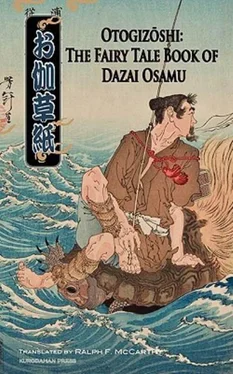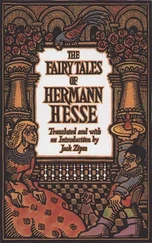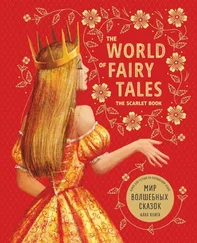Apparently a man named Urashima Taro actually lived once, long ago, in a place called Mizunoe, on the Tango Peninsula in what is now northern Kyoto Prefecture. They tell me you can still find a shrine dedicated to Taro there, in a poor little village on the coast. I’ve never visited the place myself, although I understand it’s about as desolate a stretch of beach as you’re likely to find.
At any rate, that’s where our Urashima Taro resides. He doesn’t live alone, of course, but with his mother and father. Also a younger brother and sister. Not to mention a large number of servants. He is, you see, the eldest son of an old and highly respected family. Now, eldest sons of respected families have had, from ancient times to our own, a certain characteristic in common: namely, a sense of style. Some might describe this stylishness favorably, as refinement, and others less favorably, as prodigality. But in Taro’s case the prodigality, if it can be so called, was of a sort entirely distinct from that associated with wine and women and what have you. Among second and third sons one often finds that variety of prodigal who overindulges in liquor and pursues women of lowly birth, muddying his own family’s name in the process, but the number one son is generally quite innocent of such abominable behavior. Because he is responsible for the wealth and property accumulated by his ancestors, the first-born male comes naturally to acquire a certain steadfast stodginess and to conduct himself in an impeccably proper and genteel manner. Rather than the intense floozies-and-booze version favored by his younger brothers, therefore, the eldest son’s prodigality is more of a sideline, a series of frivolous diversions. All he asks of these diversions, furthermore, is that they cement his reputation for possessing the taste and gentility that befit his station in life.
“Dear brother, you just don’t have any sense of adventure,” the younger sister, an impertinent thing of sixteen, tells him one day. “That’s what’s wrong with you.”
“No, that’s not it,” their coarse and rebellious eighteen-year-old brother chimes in. “He’s too pretty, is what it is.”
The younger brother is dark-complected and strikingly ugly.
But Urashima Taro never loses his temper, even when tested with such uninhibited criticism from his younger siblings. “To allow one’s curiosity to get the better of one is a sort of adventure,” he tells them. “And to control one’s curiosity is also a species of adventure. Both are risky propositions. There is a thing called destiny to which all men are subject.”
Exactly what he means by these words is anyone’s guess, but after pronouncing them with a calm, composed, and enlightened air, he clasps his hands behind his back and strolls out to the seashore. There, ambling aimlessly along the beach, he mutters fragments of refined and elegant poetry.
Scattered by the wind
like the tattered ends
of a worn rush mat-
the fishing boats!
“Why can’t people get along without criticizing one another?” Urashima shakes his head as he ponders this rudimentary question. “Never have the bush clover blooming on the beach, nor the little crabs who skitter o’er the sand, nor the wild geese resting their wings in yonder cove found fault with me. Would that human beings too were thus! Each individual has his own way of living. Can we not learn to respect one another’s chosen way? One makes every effort to live in a dignified and proper manner, without harming anyone else, yet people will carp and cavil and try to tear one down. It’s most vexing.”
He breathes a little sigh.
“Excuse me,” says a small voice at his feet. “Urashima-san?”
This, of course, is our famous and problematic tortoise.
I say “problematic” because, although I don’t wish to appear pedantic, I feel compelled to point out that turtles come in a great number of varieties, and that fresh-water turtles and salt-water turtles are naturally built to different specifications. The turtle we see in paintings of the goddess Benten, stretched out by the side of the pond drying its shell in the sun, is the creature I believe most of us refer to as a tortoise. And it is this same tortoise upon which in picture books we sometimes see Urashima Taro perched, one hand shading his eyes as he peers off toward the distant Dragon Palace. But were a tortoise of this sort to dive into the ocean, it would in fact choke on the salt water and promptly expire. It is usually this type of land tortoise-and not a sea turtle or soft-shelled turtle or hawksbill-that we find, along with a crane, on those ornamental stands that represent the Isle of Eternal Youth. The crane lives a thousand years, it is said, and the tortoise ten thousand, which accounts for their presence on wedding decorations and what have you, and perhaps it’s the auspicious nature of tortoises that causes illustrators of picture books to assume that Urashima-san’s guide too must have been one of these (the Isle of Eternal Youth and the Dragon Palace being similar sorts of places), but one can’t help but think it’s a bit much to ask us to imagine a land tortoise slashing away at the water with its clumsy, clawed feet, struggling toward the bottom of the sea. No, we definitely need something along the lines of a hawksbill turtle, whose wide, fin-like appendages would permit it to glide a bit more gracefully through the deep.
I must point out, however-at the risk, once again, of appearing pedantic-that this leaves us with another thorny problem. It is my understanding that the only places in the Empire where the hawksbill turtle is found are the southern islands-Ogasawara, the Ryukyus, Taiwan, and so forth-and much as I regret to say this, it’s simply not likely that a hawksbill might emerge from the Sea of Japan at a beach on the northern coast of Tango. Such being the case, and since one might argue that tales of this sort are, after all, mere flights of fancy, I considered making Urashima-san a native of Ogasawara or the Ryukyu Islands, but since ancient tradition holds that he hailed from Mizunoe, and since by all accounts an Urashima Shrine actually exists on the coast of Tango, I feel duty-bound to avoid any such indiscriminate tampering with the facts, if only out of deference for the sanctity of the Japanese historical record. No, it would appear that we must somehow impose upon a hawksbill or some other amphibious reptile of similar construction to make the long journey up through the Sea of Japan. And yet I’m reluctant to invite the scorn of persnickety zoologists who might step forward to point out the absurdity of this assertion and to denounce the appalling lack of scientific spirit displayed by irresponsible literary hacks like me.
So I gave it a little more thought. Surely, besides the hawksbill, there must be other species of sea turtle with fin-shaped appendages. Wasn’t there something called a loggerhead tortoise? Once, about ten years ago (I too am getting on in years), I spent a summer at the seashore in Numazu, and I remember the fishermen there making quite a fuss about having found on the beach a sea turtle with a shell nearly five feet in diameter. I saw the thing with my own eyes and seem to recall that it was being referred to as a loggerhead tortoise. Perfect. That’s the one for us. If it could crawl up on the beach at Numazu, perhaps we can, without causing too much pandemonium in zoological circles, prevail upon it to paddle around to the Sea of Japan and roll out of the surf at Tango. If, nonetheless, someone insists on raising a fuss about ocean currents being thus or such, well, don’t look at me. I shall calmly reply that it is indeed strange, passing strange, that the creature should turn up in a place common sense tells us it couldn’t possibly reach, and that this is proof that we’re not talking about just your average loggerhead tortoise here. That so-called scientific spirit of yours is nothing to place absolute faith in, my friends. All your theorems and axioms are nothing more than conjectures in their own right, after all. You don’t want to get too big for your breeches.
Читать дальше












